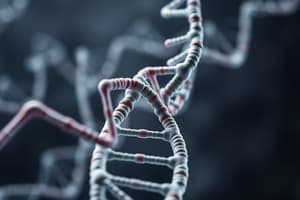Podcast
Questions and Answers
What is the primary structure of DNA?
What is the primary structure of DNA?
- Triple helix
- Double helix (correct)
- Circular form
- Single helix
Adenine pairs with Cytosine in DNA.
Adenine pairs with Cytosine in DNA.
False (B)
What are the three parts of a nucleotide?
What are the three parts of a nucleotide?
Deoxyribose sugar, phosphate group, nitrogen base
In eukaryotes, DNA is located in the ______.
In eukaryotes, DNA is located in the ______.
Match the nitrogen base with its complementary pair:
Match the nitrogen base with its complementary pair:
Which nitrogen base does NOT pair with Guanine?
Which nitrogen base does NOT pair with Guanine?
DNA replication takes place during the M-phase of the cell cycle.
DNA replication takes place during the M-phase of the cell cycle.
What is Chargaff's rule?
What is Chargaff's rule?
Flashcards
What is DNA?
What is DNA?
Deoxyribonucleic acid, a nucleic acid that contains the genetic instructions for the development and function of living organisms.
Where is DNA located?
Where is DNA located?
DNA is found in the nucleus of eukaryotic cells and in the cytoplasm of prokaryotes.
What are the components of a nucleotide?
What are the components of a nucleotide?
The building blocks of DNA are called nucleotides. Each nucleotide is made up of three parts: a deoxyribose sugar, a phosphate group, and a nitrogenous base.
What are the nitrogenous bases in DNA?
What are the nitrogenous bases in DNA?
Signup and view all the flashcards
Describe the structure of DNA.
Describe the structure of DNA.
Signup and view all the flashcards
What are the base pairing rules in DNA?
What are the base pairing rules in DNA?
Signup and view all the flashcards
What is DNA replication?
What is DNA replication?
Signup and view all the flashcards
When does DNA replication occur?
When does DNA replication occur?
Signup and view all the flashcards
Study Notes
DNA: Structure & Replication
- DNA controls all cell activities
- Found in the nucleus of eukaryotic cells
- Found in the cytoplasm of prokaryotic cells (bacteria)
- DNA is an abbreviation for Deoxyribonucleic Acid
- DNA is a nucleic acid, one of the four biomolecules
- DNA is made of smaller building blocks called nucleotides
- Nucleotides have three parts:
- Deoxyribose sugar (a pentagon-shaped 5-carbon sugar)
- Phosphate group
- Nitrogenous base
- There are four types of nitrogenous bases:
- Thymine (T)
- Adenine (A)
- Cytosine (C)
- Guanine (G)
Simple Nucleotide Structure
- Nucleotides consist of a phosphate group attached to a sugar molecule, which is then attached to a nitrogenous base
DNA Structure
- Nucleotides bond together to form the DNA molecule
- DNA has a double helix shape, resembling a spiral staircase
- When unwound, DNA looks like a ladder
- The "rails" or "backbone" of the ladder are alternating sugar and phosphate molecules
- The "rungs" or "steps" of the ladder are complementary pairs of nitrogenous bases
- Nitrogenous bases are held together by hydrogen bonds
- These hydrogen bonds can be easily broken for replication
Complementary Nitrogen - Base Pairing
- Nitrogenous bases bond in a specific manner:
- Adenine (A) bonds with Thymine (T)
- Cytosine (C) bonds with Guanine (G)
- This is known as Chargaff's rule
- Each side of the DNA ladder (strand) is antiparallel to the other
DNA Replication
- DNA must be copied for cell division, through a process called replication.
- Replication occurs during the S-phase of interphase
- Enzymes are essential for replication
- Key enzymes for Replication are:
- Helicase (unzips the DNA)
- Polymerase (adds new complementary nucleotides)
- Replication results in two identical DNA molecules
- Each new DNA molecule has one old strand and one new strand
Studying That Suits You
Use AI to generate personalized quizzes and flashcards to suit your learning preferences.




